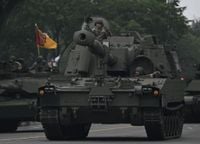On November 17, 2025, the world woke to headlines that felt like echoes of centuries past: the United States, under President Donald Trump, is doubling down on a doctrine of hemispheric dominance, one that’s both familiar and unsettlingly modernized. The so-called “Donroe Doctrine”—a term coined by analysts to describe Trump’s aggressive revival of the 19th-century Monroe Doctrine—has become the centerpiece of a sweeping campaign to reassert U.S. influence across Latin America and the Caribbean. This time, the stakes are higher, the rivals sharper, and the methods more forceful than ever.
To understand how we got here, let’s take a step back. The original Monroe Doctrine, declared by President James Monroe in 1823, was a warning to European powers: keep out of the Western Hemisphere, or risk confrontation with the United States. Over the decades, this principle morphed from a shield against colonialism into a tool for U.S. intervention—sometimes diplomatic, sometimes military—whenever Washington sensed its interests were threatened south of the border. Fast forward to today, and that doctrine has been dusted off, turbocharged, and rebranded for a new era of global competition.
According to Al Día News, Trump’s “Donroe Doctrine” is not just about keeping Europe (or now, China) out of America’s backyard. It’s about actively shaping which governments in Latin America are deemed acceptable, and which are targeted for pressure—or worse. The doctrine’s playbook is threefold: reward allies with financial aid and diplomatic attention; punish defiant governments with sanctions, economic restrictions, or outright military threats; and wrap it all in the language of “hemispheric security.” The message is clear: align with Washington, or face consequences.
This is not just rhetoric. In recent months, the U.S. has dramatically escalated its military presence in the region. CounterPunch reported that Secretary of War Pete Hegseth announced the launch of Operation Southern Spear, a campaign targeting so-called “narco-terrorists” with an unmistakable focus on Venezuela. The U.S. has deployed Marines, naval assets, and even the Navy’s largest aircraft carrier—the USS Gerald R. Ford—to the Southern Caribbean. The official justification? Combating the flow of drugs like fentanyl and dismantling criminal organizations such as Venezuela’s Tren De Aragua, led by Nino Guerrero. But critics argue that the war on drugs is a “cynical pretext to conceal the true goal: to impose its objectives in Venezuela and recolonize Latin America.”
Since August 2025, these operations have had deadly results. As reported by The Organization for World Peace, U.S. air assets have killed 69 individuals associated with drug cartels in the Caribbean. On September 2, 2025, President Trump himself announced the U.S. Navy’s first airstrike in the region against a Venezuelan vessel, resulting in the deaths of all eleven people onboard. Meanwhile, CounterPunch notes the total death toll from U.S. attacks on boats around Venezuela has climbed to about 80, with the Pentagon offering little public evidence that these vessels were truly being used for drug trafficking.
The military buildup doesn’t stop at sea. U.S. soldiers and Marines have resumed jungle training in Panama for the first time in decades, and plans are underway to revive deactivated bases in Panama, Puerto Rico, and Ecuador. According to reports, the Trump administration’s draft national security strategy—expected to be made public soon—names the Western Hemisphere as the top priority for U.S. military operations. This marks a decisive shift away from traditional hotspots like the Middle East or Asia-Pacific, placing Latin America and even domestic deployments under the “war on narco-terrorism” umbrella.
Not surprisingly, these moves have provoked fierce reactions abroad. Russia, itself embroiled in a grinding conflict in Ukraine and facing international sanctions, has seized the opportunity to challenge U.S. actions in the Caribbean. The Russian Foreign Ministry, as cited by Reuters, condemned the U.S. operations as a “direct violation of international and domestic laws.” For Moscow, defending Venezuela is not just about principle—it’s about expanding its influence in America’s backyard, much as the Soviet Union tried during the Cold War. Venezuelan President Nicolás Maduro, embattled at home and abroad, has declared his country at “maximum preparedness” and threatened to constitutionally declare a “republic in arms” if U.S. strikes continue, according to AP News.
For students of history, the parallels are impossible to ignore. The Monroe Doctrine and its Roosevelt Corollary once justified U.S. interventions throughout Latin America, from the Venezuela debt crisis of 1902 to the Cuban Missile Crisis of 1962. The Caribbean, long a chessboard for global powers, is again a flashpoint for proxy conflict. As The Organization for World Peace observes, Russia’s support for Maduro is a direct descendant of Cold War strategy—using regional tensions to erode U.S. dominance while claiming the moral high ground.
But while the rhetoric of law and sovereignty fills official statements, the reality on the ground is more complicated—and more dangerous. Analysts warn that Trump’s strategy risks weakening already fragile democratic institutions in Latin America, turning U.S. aid into a tool for political loyalty rather than a means to strengthen rights or the rule of law. “The official justification—the fight against ‘narco-terrorism’ and the flow of drugs like fentanyl—is a hypocritical veil that has been clearly exposed,” writes Milton D’Leon in La Izquierda Diario. “It is a cynical pretext to conceal the true goal: to impose its objectives in Venezuela and recolonize Latin America.”
There’s also a domestic angle that can’t be ignored. Trump’s threats to deploy the National Guard to U.S. cities under the same anti-narcotics justification have met stiff resistance from local communities and some within the U.S. military establishment. As CounterPunch points out, the militarization of the Western Hemisphere is deeply intertwined with the militarization of U.S. cities—a reminder that the logic of dominance abroad often seeps back home.
Of course, not everyone in Washington is on board with this escalation. While there’s long been bipartisan support for U.S. military engagement in Latin America, the scale and intensity of the current campaign have raised eyebrows. Critics argue that such interventions bring “nothing but misery for the working people and oppressed of the region, all so U.S. companies can pillage natural resources and exploit local labor.” Supporters, meanwhile, insist that hemispheric security is non-negotiable in an era of rising global threats, and that strong action is needed to combat drug trafficking and hostile foreign powers.
What’s clear is that the hemisphere stands at a crossroads. The Donroe Doctrine’s blend of rewards and punishments, military might and diplomatic pressure, has reopened old wounds and reignited historic dilemmas: sovereignty versus cooperation, autonomy versus dependency, security versus democracy. As the U.S., Russia, and regional actors maneuver for advantage, the region’s future hangs in the balance—its fate shaped by doctrines as old as the republic itself, but as urgent as this morning’s headlines.
Amid the saber-rattling and diplomatic posturing, Latin America’s people face the consequences of great power rivalry. Whether the hemisphere can break free from this cycle of intervention and resistance remains to be seen, but one thing is certain: the story is far from over.


